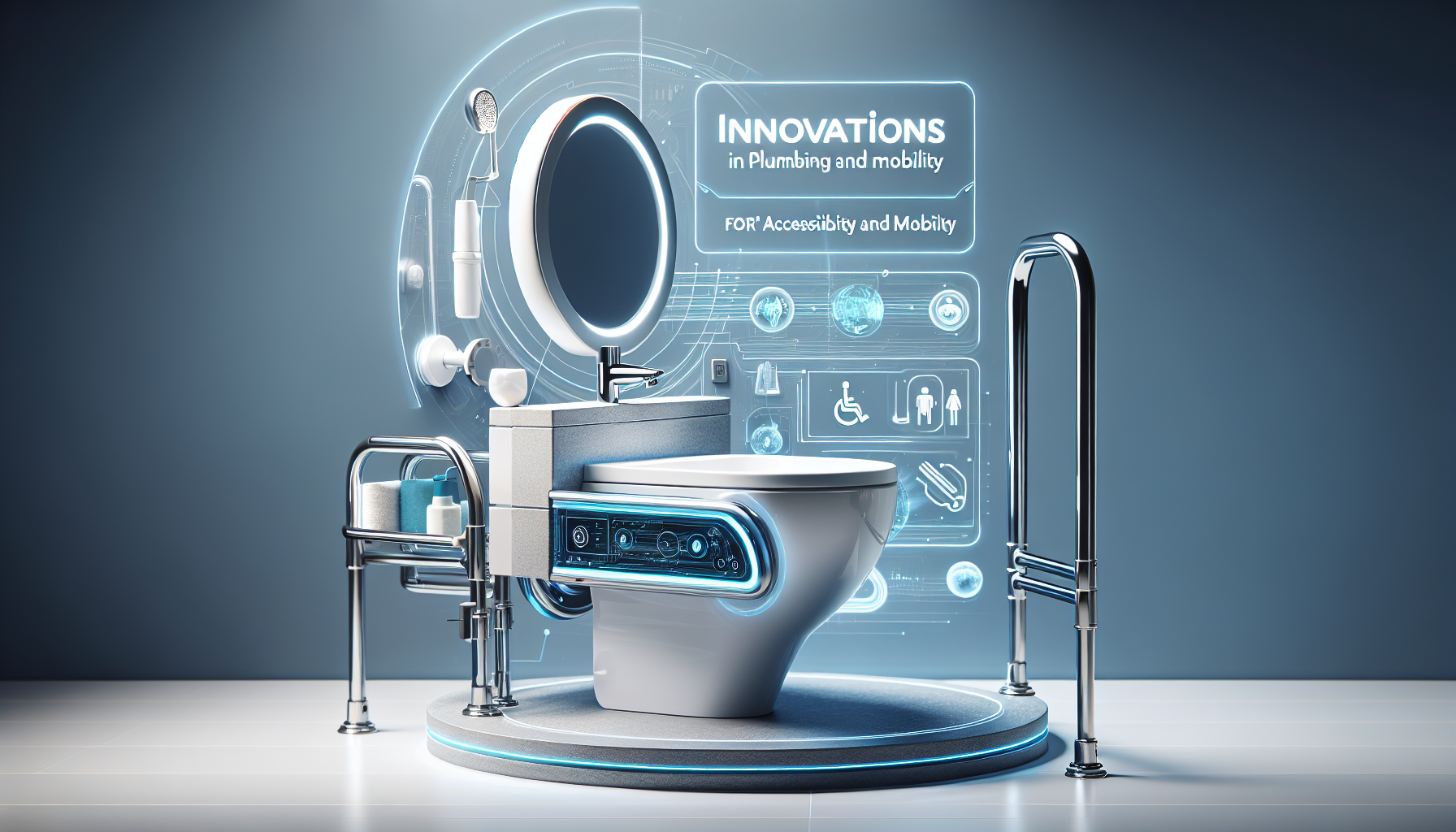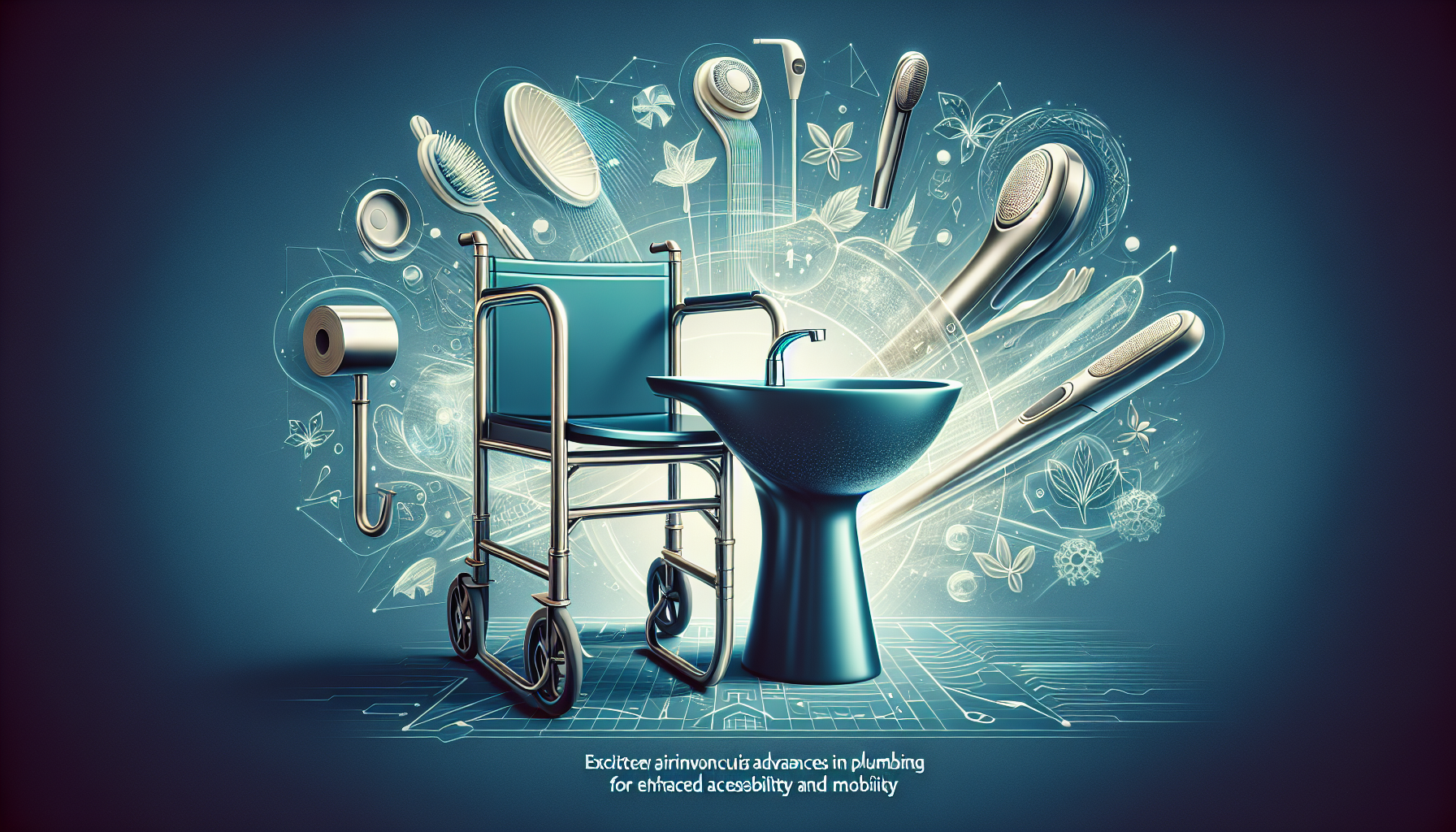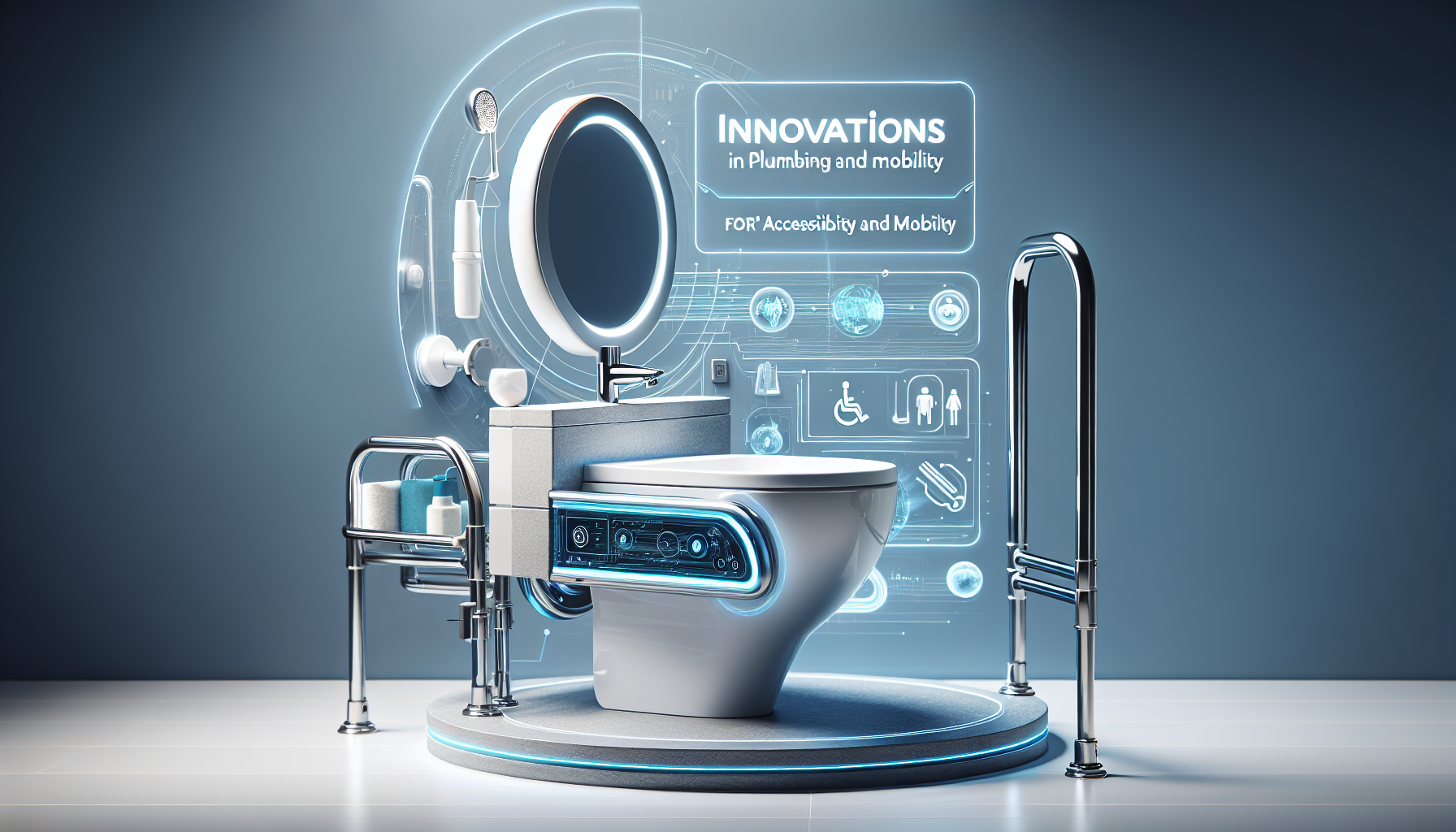Are you tired of struggling with outdated plumbing systems that hinder your mobility or limit your accessibility? Well, fret no more because innovations in plumbing are here to revolutionize your experience. From user-friendly faucets with motion sensors to adjustable showerheads that cater to individuals with limited mobility, these new advancements address the unique needs of people of all abilities. Say goodbye to unnecessary obstacles and embrace a world of convenience and comfort with these incredible innovations.

1. Advanced bathroom fixtures and accessories
When it comes to creating a bathroom that is not only functional but also stylish and accessible, advanced bathroom fixtures and accessories can make a world of difference. From lever-handle faucets to touchless faucets and adjustable-height sinks, these innovations are designed to enhance the overall user experience and cater to individuals with varying degrees of mobility.
1.1 Lever-handle faucets
Lever-handle faucets have become increasingly popular in both residential and commercial settings. With their easy-to-operate lever handles, they provide a convenient solution for individuals who may have limited dexterity or strength in their hands. Whether you have arthritis or simply prefer a user-friendly option, lever-handle faucets offer a smooth experience with precise control over water temperature and flow.
1.2 Touchless faucets
In today’s world, where hygiene is more important than ever, touchless faucets have emerged as a game-changer in the realm of bathroom fixtures. These innovative faucets utilize sensor technology to detect the presence of hands, allowing water to flow without the need for physical contact. Not only do touchless faucets minimize the spread of germs and bacteria, but they also promote water conservation by automatically shutting off after a designated period of inactivity.
1.3 Adjustable-height sinks
For individuals who use wheelchairs or have limited mobility, adjustable-height sinks can significantly improve accessibility and comfort in the bathroom. These sinks feature a flexible design that allows them to be raised or lowered to a desired height, ensuring that individuals of all heights can easily access the sink and perform daily tasks with ease. Adjustable-height sinks can be operated manually or through electronic controls, providing a customizable solution for everyone.
2. High-tech toilets
As technology continues to advance, it has made its way into our bathrooms, transforming the humble toilet into a high-tech marvel. With options such as intelligent bidet toilets, self-cleaning toilets, and even remote-controlled toilets, there is no shortage of innovative features to enhance your bathroom experience.
2.1 Intelligent bidet toilets
Intelligent bidet toilets combine the functions of a traditional toilet and bidet into one sleek and sophisticated unit. These toilets offer a range of features, including built-in bidet sprays, heated seats, warm air drying, and even automated lid opening and closing. With customizable settings and intuitive controls, intelligent bidet toilets provide a hygienic and luxurious experience for users of all abilities.
2.2 Self-cleaning toilets
Cleaning the toilet is nobody’s favorite chore, but self-cleaning toilets aim to change that. Equipped with advanced cleaning mechanisms and antimicrobial surfaces, these toilets can automatically clean and disinfect themselves after each use. With the touch of a button, the toilet bowl is thoroughly scrubbed, eliminating the need for manual cleaning and ensuring optimal hygiene.
2.3 Remote-controlled toilets
Imagine being able to control your toilet’s functions from the convenience of your smartphone or a dedicated remote control. Remote-controlled toilets allow you to do just that. Whether it’s adjusting the water temperature, activating the bidet feature, or flushing the toilet, these high-tech toilets offer a new level of convenience and independence for users with mobility challenges.
3. Barrier-free showers and bathtubs
Inclusive and accessible design extends beyond just bathroom fixtures; it also encompasses the layout and construction of showers and bathtubs. Barrier-free showers and walk-in tubs have gained traction for their ability to accommodate individuals with limited mobility and ensure a safe bathing experience.
3.1 Roll-in showers
Roll-in showers are designed with a seamless entry, allowing individuals to easily roll their wheelchair or shower chair into the showering area. These showers typically feature a minimal or no threshold, eliminating the need for users to step over any barriers. With built-in grab bars and non-slip flooring, roll-in showers promote independence and reduce the risk of slips and falls.
3.2 Walk-in tubs
For those who prefer a relaxing soak in a bathtub, walk-in tubs provide a convenient and accessible solution. These tubs have a door that opens inward, allowing users to step into the tub without having to lift their legs over a traditional high-sided bathtub. With built-in seating, grab bars, and non-slip surfaces, walk-in tubs offer a comfortable and safe bathing experience for individuals of all abilities.
3.3 Transfer benches
To further enhance accessibility within the shower or bathtub area, transfer benches can be used. These benches span the edge of the tub or shower, providing a sturdy seat for individuals to transfer onto before sliding into the bathing area. Transfer benches often feature adjustable height settings and armrests, ensuring a secure and comfortable experience for those with limited mobility.
4. Automated faucets and flush systems
In the pursuit of convenience, automated faucets and flush systems have become increasingly popular. By eliminating the need for physical contact, these advanced systems not only offer a hygienic solution but also help conserve water by ensuring precise control over flow and flushing mechanisms.
4.1 Sensor-activated faucets
Sensor-activated faucets utilize infrared technology to detect the presence of hands, automatically triggering the flow of water. This hands-free operation not only reduces the spread of germs but also eliminates the risk of accidentally leaving the faucet running. Sensor-activated faucets are an excellent choice for individuals with limited hand mobility or those who value cleanliness and convenience.
4.2 Self-flushing toilets
Say goodbye to manually operating the flush handle or button with self-flushing toilets. These toilets utilize sensor technology to detect when the user has finished their business, triggering an automatic flush. Not only does this eliminate the need for physical contact, but it also ensures that the toilet is always left clean and fresh for the next user.
4.3 Voice-controlled water systems
For an even more futuristic and hands-free experience, voice-controlled water systems have made their way into the realm of plumbing. By integrating with smart home devices or dedicated voice assistants, these systems allow users to control the flow and temperature of water with simple voice commands. Voice-controlled water systems provide a new level of accessibility and convenience, especially for those with limited dexterity or mobility.

5. Smart home integration
As we strive for seamless connectivity in our homes, the integration of plumbing systems with smart home technology has become a reality. From voice-activated controls to mobile app-controlled plumbing systems, these innovations enable individuals to effortlessly manage their bathroom functions and optimize accessibility.
5.1 Voice-activated controls
Voice-activated controls have revolutionized the way we interact with our homes, and the bathroom is no exception. By integrating with smart home devices or voice assistants, such as Amazon Alexa or Google Assistant, users can control various bathroom functions through simple voice commands. From adjusting water temperature to activating specific features, voice-activated controls enhance accessibility and provide a new level of convenience.
5.2 Mobile app-controlled plumbing systems
Gone are the days of manual adjustments and guesswork when it comes to plumbing systems. With mobile app-controlled plumbing systems, you can now monitor and control your bathroom fixtures directly from your smartphone or tablet. Whether it’s adjusting the water temperature, setting personalized preferences, or receiving maintenance alerts, these apps offer a user-friendly interface and enhanced accessibility for individuals of all abilities.
5.3 Home automation for accessibility
Home automation has the power to transform the way we interact with our living spaces, and when applied to plumbing systems, it can greatly enhance accessibility. By integrating smart home technology with plumbing fixtures, individuals can create customized settings that cater to their specific needs. For instance, you can program your shower to automatically adjust to your preferred water temperature and pressure or set your bathtub to fill up to a specific level. These personalized automation features ensure a comfortable and effortless experience for all users.
6. Water-saving technology
Water conservation is a pressing global concern, and plumbing innovations have played a significant role in addressing this issue. From low-flow fixtures to dual-flush toilets and greywater recycling systems, there are numerous advancements that promote water efficiency without compromising functionality.
6.1 Low-flow fixtures
Low-flow fixtures, such as faucets, showerheads, and toilets, are designed to reduce water usage by optimizing the flow rate without sacrificing performance. These fixtures incorporate aerators, flow restrictors, and advanced engineering to deliver a satisfying water experience while significantly reducing water consumption. By using less water per use, low-flow fixtures contribute to both water conservation efforts and cost savings on utility bills.
6.2 Dual-flush toilets
Dual-flush toilets offer a practical and sustainable solution for optimizing water usage in the bathroom. These toilets feature two flush options – a full flush for solid waste and a reduced flush for liquid waste. By providing the flexibility to choose the appropriate flush for each scenario, dual-flush toilets help conserve water by only using the necessary amount for each flush. This innovation allows users to actively contribute to water conservation without compromising their daily routine.
6.3 Greywater recycling systems
Greywater recycling systems take water conservation to the next level by reusing water from sinks, showers, and appliances for non-potable purposes. These systems collect, treat, and store greywater, which can then be used for activities such as flushing toilets or watering plants. By minimizing the demand for freshwater and reducing wastewater discharge, greywater recycling systems offer a sustainable approach to water usage that benefits both the environment and homeowners’ wallets.
7. Anti-scald devices and temperature control
Safety is a paramount concern in any bathroom, and plumbing innovations have been developed to mitigate the risk of scalding and ensure consistent, comfortable water temperatures. Thermostatic mixing valves, instant hot water systems, and temperature-controlled shower heads are among the key advancements in this area.
7.1 Thermostatic mixing valves
Thermostatic mixing valves are designed to maintain a consistent water temperature, regardless of fluctuations in the hot and cold water supply. These valves automatically blend hot and cold water to achieve a pre-set temperature, preventing scalding accidents caused by sudden temperature changes. With precise temperature control, thermostatic mixing valves prioritize user safety and provide peace of mind during every shower or bath.
7.2 Instant hot water systems
Waiting for hot water to reach the desired temperature can be both frustrating and wasteful. Instant hot water systems solve this problem by providing an immediate supply of hot water at the desired temperature upon demand. These systems are often installed directly at the point of use, such as beneath sinks or showers, ensuring that hot water is readily available without the need for wasteful running of tap water. Instant hot water systems enhance user comfort and contribute to overall water conservation efforts.
7.3 Temperature-controlled shower heads
Temperature-controlled shower heads offer users the ability to set and maintain their preferred water temperature throughout the duration of their shower. These shower heads incorporate thermostatic technology, which regulates water temperature to prevent sudden, unexpected fluctuations. Whether you prefer a slightly cooler or warmer shower, temperature-controlled shower heads ensure a consistent and enjoyable experience, all while minimizing the risk of scalding.
8. Wheelchair-accessible sinks and countertops
For individuals who use wheelchairs or have limited mobility, traditional sinks and countertops can pose significant challenges. However, with the introduction of wheelchair-accessible sinks and height-adjustable countertops, these barriers are being broken down to provide equal access for all.
8.1 Height-adjustable countertops
Height-adjustable countertops are a game-changer for individuals who use wheelchairs or have varying heights. These countertops can be electronically or manually adjusted, allowing users to customize the height to their specific needs. Whether you are seated in a wheelchair or prefer a standing position, height-adjustable countertops ensure optimal accessibility and comfort during daily bathroom activities.
8.2 Knee space under sinks
Traditional sinks often lack the necessary knee space for wheelchair users to comfortably position themselves. Wheelchair-accessible sinks address this issue by featuring an open design that provides ample room under the sink for knees and wheelchair footrests. With the addition of properly placed faucets, individuals can easily reach the sink without any obstructions, promoting independence and ease of use.
8.3 Open shelving for easy access
Open shelving is an increasingly popular choice for accessible bathrooms, as it offers easy access to essentials without the barriers presented by closed cabinets and drawers. By providing open shelves beneath the sink or near the shower area, individuals can conveniently store and retrieve toiletries, towels, and other necessities without the need to reach or bend excessively. Open shelving fosters an inclusive environment that promotes independence and convenience for all users.
9. Plumbing for aging in place
As individuals age, their needs and abilities may change, requiring modifications to their living spaces. Plumbing innovations for aging in place, such as grab bars and handrails, walk-in showers with built-in seating, and non-slip flooring, offer practical solutions for maintaining independence and safety as mobility decreases.
9.1 Grab bars and handrails
Grab bars and handrails are essential additions to any bathroom, especially for individuals with limited mobility or stability concerns. These fixtures provide reliable support and stability, effectively reducing the risk of slips and falls. Whether strategically placed near the toilet, shower, or bathtub, grab bars and handrails offer users the confidence and assistance they need to navigate the bathroom environment with ease.
9.2 Walk-in showers with built-in seating
Walk-in showers with built-in seating provide an accessible and comfortable bathing solution for individuals who may have difficulty standing for extended periods. These showers feature a seating area that allows users to shower while comfortably seated, reducing the risk of falls and providing a safe and enjoyable bathing experience. With thoughtful design and non-slip surfaces, walk-in showers with built-in seating cater to individuals who desire greater accessibility and convenience.
9.3 Non-slip flooring
Maintaining a firm and stable footing is crucial for individuals of all ages, but particularly for those with reduced mobility or balance. Non-slip flooring options, such as textured tiles or slip-resistant coatings, greatly minimize the risk of slips and falls in the bathroom. By providing a secure and stable surface to walk on, non-slip flooring ensures the safety and confidence of all users, regardless of their mobility limitations.
10. Innovative pipe materials and installation techniques
While the focus of plumbing innovations often lies in the fixtures and features, advancements in pipe materials and installation techniques should not be overlooked. With the introduction of PEX piping, trenchless pipe repair, and insulated water lines for freeze prevention, plumbing systems have become more efficient, durable, and accessible.
10.1 PEX piping
PEX (cross-linked polyethylene) piping has gained immense popularity in recent years due to its flexibility, durability, and ease of installation. Unlike traditional copper or rigid plastic pipes, PEX pipes can be bent and shaped to accommodate various plumbing layouts, reducing the need for excessive fittings and joints. The flexible nature of PEX pipes also minimizes the risk of burst pipes, making them an excellent choice for both new construction and retrofitting projects.
10.2 Trenchless pipe repair
Traditional pipe repair often involved extensive excavation and disruption to the surrounding environment. However, with trenchless pipe repair techniques, such as pipe lining and pipe bursting, plumbing repairs can now be completed with minimal damage and disruption. These methods allow for the rehabilitation or replacement of existing pipes without the need for extensive digging, reducing costs and minimizing the impact on accessibility during repair processes.
10.3 Insulated water lines for freeze prevention
Freezing temperatures can wreak havoc on plumbing systems, causing pipes to burst and leaving homeowners with extensive repairs. To combat this issue, the use of insulated water lines has become increasingly prevalent. These pipes are designed to protect against freezing by incorporating insulation materials that provide an additional layer of warmth to the water flowing through them. Insulated water lines not only prevent freezing-related damage but also ensure a continuous flow of water, even in the harshest winter conditions.
In conclusion, plumbing innovations have come a long way in promoting accessibility and mobility in the bathroom. From advanced bathroom fixtures and high-tech toilets to barrier-free showers and innovative pipe materials, these advancements cater to individuals of all abilities. With the integration of smart home technology and a focus on water conservation, plumbing systems have become more connected, efficient, and sustainable. Whether you’re looking to enhance accessibility, improve safety, or reduce water usage, there is a wide range of plumbing innovations available to transform your bathroom into a functional and inclusive space.

